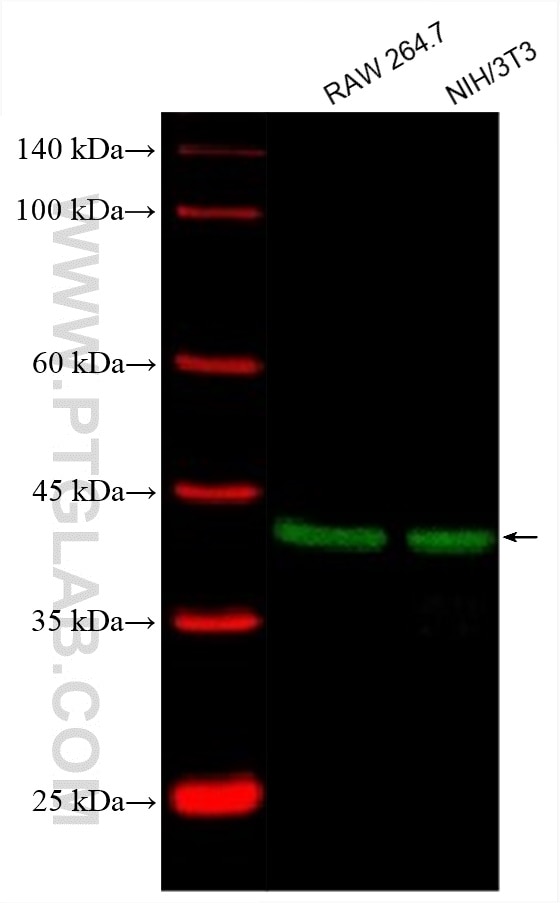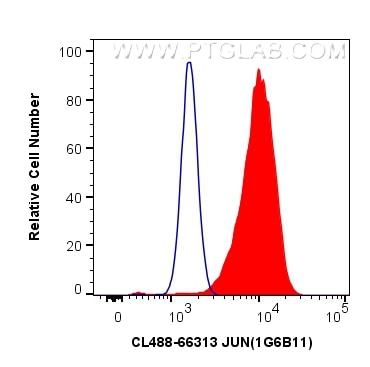Validation Data Gallery
Tested Applications
| Positive WB detected in | RAW 264.7 cells |
| Positive FC (Intra) detected in | NIH/3T3 cells |
Recommended dilution
| Application | Dilution |
|---|---|
| Western Blot (WB) | WB : 1:500-1:1000 |
| Flow Cytometry (FC) (INTRA) | FC (INTRA) : 0.40 ug per 10^6 cells in a 100 µl suspension |
| It is recommended that this reagent should be titrated in each testing system to obtain optimal results. | |
| Sample-dependent, Check data in validation data gallery. | |
Product Information
CL488-66313 targets JUN in WB, FC (Intra) applications and shows reactivity with human, mouse, rat samples.
| Tested Reactivity | human, mouse, rat |
| Host / Isotype | Mouse / IgG1 |
| Class | Monoclonal |
| Type | Antibody |
| Immunogen | JUN fusion protein Ag17639 相同性解析による交差性が予測される生物種 |
| Full Name | jun oncogene |
| Calculated molecular weight | 331 aa, 36 kDa |
| Observed molecular weight | 39 kDa |
| GenBank accession number | BC068522 |
| Gene Symbol | JUN |
| Gene ID (NCBI) | 3725 |
| RRID | AB_3672909 |
| Conjugate | CoraLite® Plus 488 Fluorescent Dye |
| Excitation/Emission maxima wavelengths | 493 nm / 522 nm |
| Form | Liquid |
| Purification Method | Protein G purification |
| UNIPROT ID | P05412 |
| Storage Buffer | PBS with 50% glycerol, 0.05% Proclin300, 0.5% BSA , pH 7.3 |
| Storage Conditions | Store at -20°C. Avoid exposure to light. Stable for one year after shipment. Aliquoting is unnecessary for -20oC storage. |
Background Information
What is the molecular weight of JUN?
The molecular weight of JUN is approximately 39 kDa.
What is the cellular localization of JUN?
JUN expression can be located in the nucleus. However, ubiquitinated JUN colocalizes with lysosomal proteins (PMID: 15469925).
What is the function of JUN?
JUN is a basic leucine zipper (bZIP) transcription factor that recognizes and binds to a consensus heptamer motif of 5'-TGA[CG]TCA-3' in the enhancer region of target genes. JUN acts as either a homo- or heterodimer and binds to the DNA to regulate transcriptional activity, specifically promoting the activity of NR5A1 when phosphorylated by HIPK3, leading to increased steroidogenic gene expression upon the stimulation of the cAMP signaling pathway (PMID: 9732876).
What post-translational modifications is JUN subjected to?
JUN is acetylated at Lys-271 by EP300 (PMID: 11689449). JUN is phosphorylated by PLK3 following exposure to hypoxia or UV irradiation, which leads to increased DNA-binding activity (PMID: 27281822), and also by PAK2 at numerous threonine residues to promote cell proliferation and transformation (PMID: 21177766). JUN is also phosphorylated by DYRK2 at Ser-243, which primes it for subsequent further phosphorylation by GSK3B and reduces its ability to bind DNA (PMID: 22307329).
What is the role of JUN in disease?
Activation of JUN is linked with proliferation and angiogenesis in invasive breast cancers (PMID: 16733206).
Protocols
| Product Specific Protocols | |
|---|---|
| WB protocol for CL Plus 488 JUN antibody CL488-66313 | Download protocol |
| FC protocol for CL Plus 488 JUN antibody CL488-66313 | Download protocol |
| Standard Protocols | |
|---|---|
| Click here to view our Standard Protocols |

